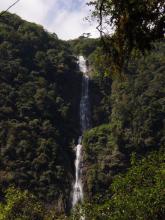Explore Bhutan Cultural Library

This collection contains essays on various genres of oral traditions in Bhutan, as well as other cultural subjects. Each text is linked to relevant places and subjects, such that users can explore the rich tapestry of Bhutanese culture through different media.
Texts in this collection
The list below includes texts from this Collection’s Subcollections.
An overview of three ways in which Bhutanese can pacify non-human spirits through ritual actions.
A summary of the forms and functions of protection cords worn to protect an individual from human and non-human obstacles.
Sur is the offering of smell. In the Buddhist worldview, there are many kinds of sentient beings. Some of them survive by eating solid food, some by consuming smell and some merely through touch or psychological nutrition through the force of the mind.
This piece was initially published in Bhutan’s national newspaper Kuensel in a series called "Why we do what we do".
An overview of the roles and utility of Tha Damtshik, which refers to integrity.
A summary of Bhutan's textile arts, from the raw materials, tools used in weaving, to the main patterns associated with different parts of the country.
A summation of the eight auspicious substances of Buddhism, each of which is associated with an event in the life of the Buddha Śākyamuni.
The functions and structures of miniature shrines known as Tashi Gomang, and their status in modern Bhutan.
An introduction to the functions of a common Bhutanese prayer for auspiciousness, including an English translation of its verses.
Summary of the eight auspicious symbols and their associated qualities.
A basic account of interdependent causation (tendrel) and how understanding it informs one's perspective of ritual action and individual practice.
A summary of the contents and main editions of the Tengyur used in Bhutan.
The rationale, proper mechanisms and appropriate mindset for conducting Tenzhug/Zhabten prayers, which aim to extend the life of Buddhist teachers.
A summary of the terma, or treasure, tradition, and those who reveal them, known as tertons.
A summary of the bawdy folk performance known as Pholey Moley.
A festival and its songs particular to the Laya-based cultures of Bhutan.
A summary of the origins and definition of the Buddhist Middle Way from the Bhutanese perspective.
One of a series of essays that explore the names associated with Bhutan throughout its history; this one highlights theories behind the name "Bhutan" and its various sources.
A summation of the first of the four noble truths as taught by Buddha Shakyamuni, from the Bhutanese perspective.
A summation of the second of the four noble truths as taught by Buddha Shakyamuni, from the Bhutanese perspective.
A summation of the third of the four noble truths as taught by Buddha Shakyamuni, from the Bhutanese perspective.
A summation of the fourth of the four noble truths as taught by Buddha Shakyamuni, from the Bhutanese perspective.
A summary of the three types of dzong encountered in Bhutan.
Before one eats the food, one should first offer it to others, particularly to enlightened beings who are worthy of such offering. One can do that by putting a small portion, representing the cream of the food (phue) in front of a shrine. Bhutanese call this toh phue for food, jah phue for tea and chang phue for alcohol.
This piece was initially published in Bhutan’s national newspaper Kuensel in a series called "Why we do what we do".